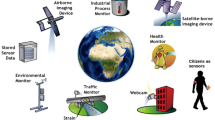Abstract
Geographic Information Systems (GISs) and digital maps are increasingly available to the computer-using humanities scholar. As a result, questions of data availability and validity are the more crucial. Digital maps may be stored in different formats, both as regards coordinate systems in use and the level of sophistication available for storing geographical information related to the maps. The maps themselves are often under copyright by a national survey agency and the situation in Norway is outlined. Historical sources may often contain geographic references to administrative units that are no longer valid. An example is taken from the University Museum of Antiquities in Oslo. Finally, an example is given of a project where maps from 1880 and 1910 are used in an architectural history project.
Similar content being viewed by others
References
Bergen, City of.Numerering af Grundeiendommene i Bergen. Bergen, 1882.
Brosveet, J., T.G. Olaussen and T. Sande.Kommuneendringer 1838–1978, Del 1: Kilder og koeffesientberegninger. Bergen: NSD rapporter 26, 1979a.
Brosveet, J., T.G. Olaussen and T. Sande.Kommuneendringer 1838–1978, Del 2: Koeffisienter og endringstall. Bergen: NSD rapporter 27, 1979b.
Fladby, R., L.T. Andressen, Alfhild N. Libæk and T. Schou, eds.Gamle norske kart: samkatalog over utrykte kart fra de siste 300 år. 18 vols. Oslo: Universitetsforlaget, 1979–85.
Harris, C.J.Bergen i kart fra 1646 til vårt århundre. Bergen: Eide forlag, 1991.
Lee, S. “Hypermedia in the Trenches: First World War Poetry inHyperCard.” Paper given at the ACH/ALLC conference, Georgetown University, Washington DC, June 16–19, 1993.
Maling, D.H.Coordinate Systems and Map Projections. 2nd ed. Oxford: Pergamon Press, 1992.
Morland, K. and E. Ore.Peer Gynt i Hypermedia. NCCH, 1993 (in press).
Ore, C.-E. “Making an Information System for the Humanities.”Computers and the Humanities. See this issue.
Snyder, J.P.Map Projections: A Working Manual. U.S. Geological Survey Professional Paper 1395. Washington, 1987
Statens Kartverk.SOSI spesifikasjoner: brukerveiledning. Hønefoss, 1990.
Author information
Authors and Affiliations
Additional information
Espen S. Ore holds a degree in the humanities from the University of Oslo. He has also studied computer science at the universities of Oslo and Bergen. Since 1984 he has been employed at the Norwegian Computing Centre for the Humanities. He has worked mostly with non-latin character sets, computer graphics and multimedia. Since 1993 he has been leading a project on a typology of runic writing based on character forms.
Rights and permissions
About this article
Cite this article
Ore, E.S. Teaching new tricks to an old map. Comput Hum 28, 283–289 (1994). https://doi.org/10.1007/BF01830276
Issue Date:
DOI: https://doi.org/10.1007/BF01830276




